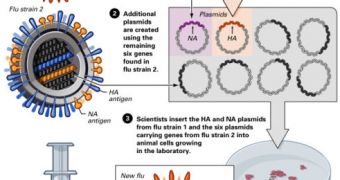Containers at the nanoscale are nothing new, as they have been demonstrated for several years, but innovative, new applications and improvements appear almost daily. In a new research, scientists at the Washington University in St. Louis (WUSL) have managed to produce a new type of nanocage that is able to open and release its contents when light is shone upon it. While this is nothing new (the technology has already been showcased by other research groups as well), the WUSL addition is the fact that the nanocages can also close back up, when light is no longer shining on them.
This type of structures is extremely important for the field of medicine, mostly because doctors are able to load vaccines or various chemicals and vitamins into the cages, and then inject them inside a patient. Specially designed proteins on the surface of the nanostructures detect a tumor, for example, and then quickly proceed towards it. Once there, an infrared, visible, or ultraviolet laser can be used to trigger the release of their cargo. This type of localized exposure to drugs is of tremendous importance.
In the case of cancer, chemotherapy drugs are known to have large numbers of side-effects, but they are widely accepted because there is no other method of keeping the patients alive long enough for new treatments to be found. With nanocages, the drugs are steered right into the tumor, and released at that location alone, which minimizes the number of healthy cells that is destroyed in the process, PhysOrg reports.
In the new approach, nanocages loaded with the chemical doxorubicin proved perfectly able to annihilate breast-cancer cells growing in a lab culture. The key to this open/close ability is a phenomenon known as surface plasmon resonance. The exact operating mechanism is published in a paper entitled “Gold nanocages covered by smart polymers for controlled release with near-infrared light,” which appears in the latest issue of the respected journal Nature Materials. The WUSL team, led by Younan Xia, PhD, also highlights the fact that the new structures are able to function at temperatures below 42 degrees Celsius, when cells usually die on account of heat.
The system also functions above 37 degrees Celsius, which is a temperature slightly more elevated than the normal one of a healthy person. The resilience or sensitivity to these temperatures are given by the precisely tailored polymers that cover this type of nanocage.

 14 DAY TRIAL //
14 DAY TRIAL //